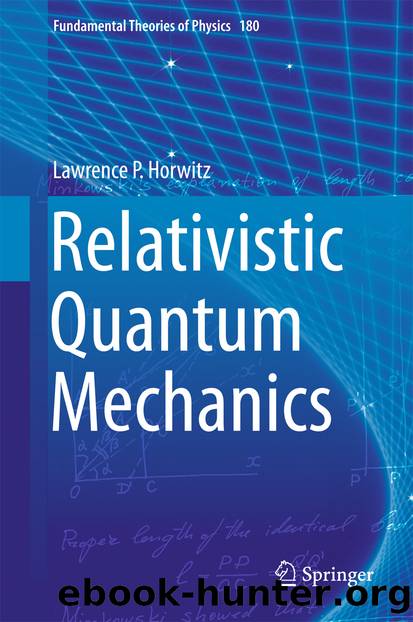Relativistic Quantum Mechanics by Lawrence P. Horwitz

Author:Lawrence P. Horwitz
Language: eng
Format: epub
Publisher: Springer Netherlands, Dordrecht
The integration over x makes possible the description of the double slit experiment in space (by coherently adding up contributions from two or more locations in x at a given t to the wave arriving at a screen over at the time ); there is, however, no integration over t, and therefore no mechanism for constructing interference in time. This result, obvious from the form of (6.2), is a reflection of the arguments of Ludwig (1982) cited above, and is fundamental to the standard nonrelativistic quantum theory. This structure constitutes a formal argument that no interference effect in time is predicted by the standard nonrelativistic Schrödinger theory. Introducing two packets into the beam of an experiment at two different times and would result in the direct sum of the two packets at some later time, say , if one propagates the first from to , and the second from to . This would constitute, by construction, a mixed state, for which no interference would take place, just as the construction of a beam of particles by adding a set of n particles with definite spin up to another set of m particles with spin down results in a mixed state described by a diagonal density matrix with a priori probability for outcome spin up, and for outcome spin down. There is no coherent superposition which would result in some spin with certainty in any direction (Jauch 1968).
To understand the apparent qualitative success of the calculations performed by the Lindner group (Lindner 2005), suppose we assume that we are dealing with ordinary functions (as distinguished from the rays in Hilbert space describing a quantum state (Wigner 1931; see also Weinberg 1995)) described by the Schrödinger evolution, and carry out an approximate calculation for short time intervals, ignoring the fact that these contributions cannot be coherent.
If we were to assume, arbitrarily, that the waves from sources at two different times could be coherently added, the propagator above could be expanded in a power series for small variations in the final time, and one would find some semblance of an interference pattern for a few maxima before distortion would set in. For the time between peaks of the laser beam, the time between peaks on the predicted “interference pattern” on a screen at a distance L from the emission source, m the mass of the electron, one finds a crude estimate (in agreement with the calculation of Lindner et al.)
Download
This site does not store any files on its server. We only index and link to content provided by other sites. Please contact the content providers to delete copyright contents if any and email us, we'll remove relevant links or contents immediately.
The Complete Stick Figure Physics Tutorials by Allen Sarah(7307)
Secrets of Antigravity Propulsion: Tesla, UFOs, and Classified Aerospace Technology by Ph.D. Paul A. Laviolette(5309)
Thing Explainer by Randall Munroe(3876)
The River of Consciousness by Oliver Sacks(3536)
The Order of Time by Carlo Rovelli(3145)
How To by Randall Munroe(3032)
A Brief History of Time by Stephen Hawking(2959)
I Live in the Future & Here's How It Works by Nick Bilton(2934)
The Great Unknown by Marcus du Sautoy(2645)
What If?: Serious Scientific Answers to Absurd Hypothetical Questions by Randall Munroe(2637)
Midnight in Chernobyl by Adam Higginbotham(2483)
Blockchain: Ultimate Step By Step Guide To Understanding Blockchain Technology, Bitcoin Creation, and the future of Money (Novice to Expert) by Keizer Söze(2444)
Networks: An Introduction by Newman Mark(2358)
The Meaning of it All by Richard Feynman(2298)
Easy Electronics by Charles Platt(2281)
The Tao of Physics by Fritjof Capra(2227)
Midnight in Chernobyl: The Untold Story of the World's Greatest Nuclear Disaster by Adam Higginbotham(2176)
When by Daniel H Pink(2082)
Introducing Relativity by Bruce Bassett(2076)
